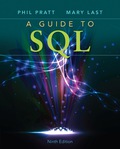
(a)
Change the requirements specified in question 7 if the student must be assigned an advisor who is in the department in which the student is majoring.
(a)
Explanation of Solution
The given DBDL in question 7 is as follows:
The changes in the DBDL after assigning an advisor who is in the department in which the student is majoring is as follows:
Since the department from which the student is majoring and the department of the advisor must be the same. Therefore, a new relation studentAdvisordept should be created in which each combination of StudentNum and AdvisorNum will be related to a common department.
(b)
Change the requirements specified in question 7 if the student’s advisor does not necessarily have to be in the department in which the student is majoring.
(b)
Explanation of Solution
The given DBDL in question 7 is as follows:
The changes in the DBDL after assigning an advisor who is not required to be in the department in which the student is majoring is as follows:
Since the department from which the student is majoring and the department of the advisor need not be the same. So, the DeprtmenttNum in Student table will refer to the DepartmentNum in Department table.
Want to see more full solutions like this?
- Write a class named Patient that has attributes for the following data: First name, middle name, and last name Address, city, state, and ZIP code Phone number Name and phone number of emergency contact The Patient class’s _ _init_ _ method should accept an argument for each attribute. The Patient class should also have accessor and mutator methods for each attribute. Next, write a class named Procedure that represents a medical procedure that has been performed on a patient. The Procedure class should have attributes for the following data: Name of the procedure Date of the procedure Name of the practitioner who performed the procedure Charges for the procedure The Procedure class’s _ _init_ _ method should accept an argument for each attribute. The Procedure class should also have accessor and mutator methods for each attribute. Next, write a program that creates an instance of the Patient class, initialized with sample data. Then, create three instances of the Procedure class,…arrow_forward1 Vo V₁ V3 V₂ V₂ 2arrow_forwardI want a full report on Sperani security according to Project Mingment.arrow_forward
- Given a 8-bit addressable (256) locations in memory and 32 locations in cache, 3 bits are in the cache Tag. What is the cache location for memory address of 0x0100 0100? Provide the answer in decimal form.arrow_forwardQ2: Solve the equation using the simplex method Max. Z 13x1 +11x2 Subject to constraints 4x1 +5x21500 5x1 +3x21575 x1 +2x2 <420 x1, x2≥0arrow_forwardBasically, you must build a desktop/android application that utilizes cryptographic techniques/protocols to secure communication (or data at rest). Try to achieve confidentiality, integrity, availability, authentication, non-repudiation (preferably all of them, otherwise few of them based on the requirement).You must demonstrate the use of these cryptographic techniques by showing some outputs/visualization results or captured traffic such as through Wireshark.1. Secure Chat ApplicationDescription: Build an encrypted chat application for desktop or Android that ensures confidentiality, integrity, authentication, and non-repudiation.Features:-- End-to-end encryption using AES-256 or Signal Protocol.--Digital signatures for non-repudiation.--Message integrity verification using HMAC.Secure login using two-factor authentication (2FA).--Server-side availability mechanisms (e.g., load balancing, backup storage). Technologies: Python (PyQt + PyCryptodome), Java (Android), Firebase for…arrow_forward
- Q1: Draw the equation of z with constraints according to the graphic method Max Z-3 P1+5 P2 s.t. P1 4 P2 6 3 P1+2 P2 <18 P1, P2 20arrow_forwardMany employees and suppliers are resistant to adopting the new e-procurement system. They are accustomed to traditional procurement methods and are hesitant to embrace the change. How would you effectively manage this resistance and ensure a smooth transition to the new system?arrow_forwardswitch status (learning, listening, for wording) Write a detailed explanation of the topic. networkarrow_forward
- Solve thisarrow_forwardSolve this please and fastarrow_forwardPlease original work Background information: Imagine you are a consultant for a fictional company, FutureTech Innovations, which specializes in advanced technology products. The company is interested in improving its decision-making processes by leveraging Business Analytics (BA) and Management Support Systems (MSS). Talk about how Online Analytical Processing (OLAP) could be used to analyze data from multiple perspectives at FutureTech. What dimensions (e.g., time, product, region) would be important, and how would OLAP enhance decision-making? Talk about the role of data visualization in helping FutureTech understand business performance. What types of visualizations (e.g., dashboards, charts) would be useful, and how would they assist in interpreting data? Please cite in text references and add weblinksarrow_forward
 Computer Networking: A Top-Down Approach (7th Edi...Computer EngineeringISBN:9780133594140Author:James Kurose, Keith RossPublisher:PEARSON
Computer Networking: A Top-Down Approach (7th Edi...Computer EngineeringISBN:9780133594140Author:James Kurose, Keith RossPublisher:PEARSON Computer Organization and Design MIPS Edition, Fi...Computer EngineeringISBN:9780124077263Author:David A. Patterson, John L. HennessyPublisher:Elsevier Science
Computer Organization and Design MIPS Edition, Fi...Computer EngineeringISBN:9780124077263Author:David A. Patterson, John L. HennessyPublisher:Elsevier Science Network+ Guide to Networks (MindTap Course List)Computer EngineeringISBN:9781337569330Author:Jill West, Tamara Dean, Jean AndrewsPublisher:Cengage Learning
Network+ Guide to Networks (MindTap Course List)Computer EngineeringISBN:9781337569330Author:Jill West, Tamara Dean, Jean AndrewsPublisher:Cengage Learning Concepts of Database ManagementComputer EngineeringISBN:9781337093422Author:Joy L. Starks, Philip J. Pratt, Mary Z. LastPublisher:Cengage Learning
Concepts of Database ManagementComputer EngineeringISBN:9781337093422Author:Joy L. Starks, Philip J. Pratt, Mary Z. LastPublisher:Cengage Learning Prelude to ProgrammingComputer EngineeringISBN:9780133750423Author:VENIT, StewartPublisher:Pearson Education
Prelude to ProgrammingComputer EngineeringISBN:9780133750423Author:VENIT, StewartPublisher:Pearson Education Sc Business Data Communications and Networking, T...Computer EngineeringISBN:9781119368830Author:FITZGERALDPublisher:WILEY
Sc Business Data Communications and Networking, T...Computer EngineeringISBN:9781119368830Author:FITZGERALDPublisher:WILEY





